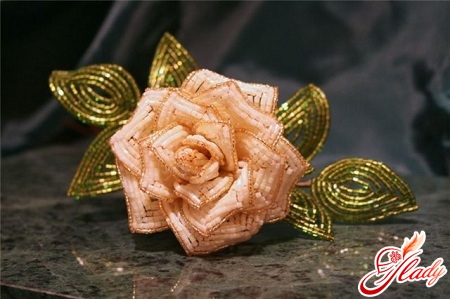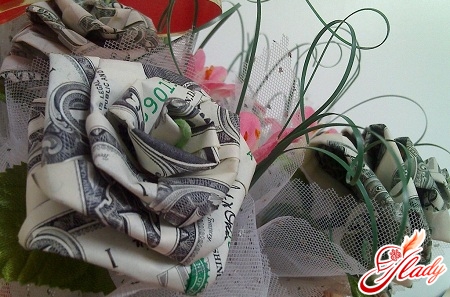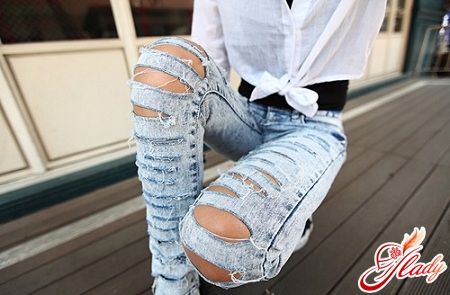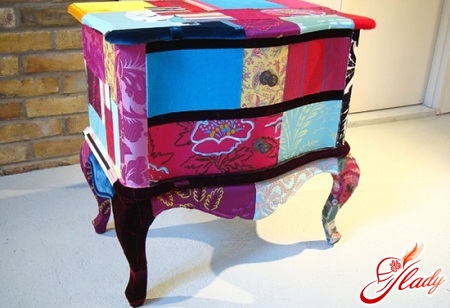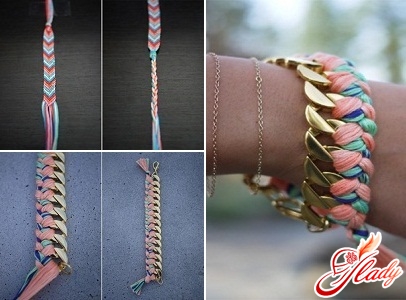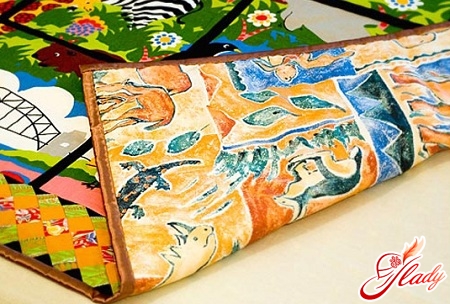 If you were into collecting as a childmosaics, then you should understand how exciting this process is. By the way, adults do not lose their passion and desire to create unpredictable bizarre patterns, correct ornaments or quite recognizable images of objects from disparate pieces. And they realize this desire with the help of no less exciting handicraft called patchwork sewing, creating with their own hands everything that can be made with fabric, thread and needle. This can be a stylized patchwork blanket, a quilted bedspread or potholders for the kitchen, clothes for adults and children, and decorative panels. And although initially patchwork sewing had completely utilitarian tasks. Today, patches are sewn into whole canvases not at all for reasons of economy, but rather from the desire to create beauty and enjoy this truly magical act. Patchwork sewing is known to almost everyone. Wherever people worked with textiles, it existed in one form or another. Today, having combined the experience of different countries, fans of patchwork call themselves quilters, create clubs of interest, organize festivals. They improve well-known old techniques, invent new ones and create with their own hands unusually effective patchwork products, which sometimes the language does not even turn to call products - just works of art. By the way, speaking about works of art, we do not sin against the truth, because for patchwork - patchwork sewing there is a completely official definition of "a type of decorative and applied art". And how many types of this very type! And the techniques of working with scraps of fabric themselves are unthinkable. Let's get acquainted with at least some of them, and at the same time find out what the basics of patchwork sewing are.
If you were into collecting as a childmosaics, then you should understand how exciting this process is. By the way, adults do not lose their passion and desire to create unpredictable bizarre patterns, correct ornaments or quite recognizable images of objects from disparate pieces. And they realize this desire with the help of no less exciting handicraft called patchwork sewing, creating with their own hands everything that can be made with fabric, thread and needle. This can be a stylized patchwork blanket, a quilted bedspread or potholders for the kitchen, clothes for adults and children, and decorative panels. And although initially patchwork sewing had completely utilitarian tasks. Today, patches are sewn into whole canvases not at all for reasons of economy, but rather from the desire to create beauty and enjoy this truly magical act. Patchwork sewing is known to almost everyone. Wherever people worked with textiles, it existed in one form or another. Today, having combined the experience of different countries, fans of patchwork call themselves quilters, create clubs of interest, organize festivals. They improve well-known old techniques, invent new ones and create with their own hands unusually effective patchwork products, which sometimes the language does not even turn to call products - just works of art. By the way, speaking about works of art, we do not sin against the truth, because for patchwork - patchwork sewing there is a completely official definition of "a type of decorative and applied art". And how many types of this very type! And the techniques of working with scraps of fabric themselves are unthinkable. Let's get acquainted with at least some of them, and at the same time find out what the basics of patchwork sewing are.
The Ace of Patchwork Technology
At first glance, there is nothing complicated about this type.there is no needlework: collect scraps, sew them into whole canvases and get finished products. Well, in some ways this opinion is true. The technology is actually not complicated. But implementing something like this is not so easy. The patchwork sewing technique includes three main stages.
This handicraft, in addition to materials (fabric and threads), also requires a certain set of tools.
- scissors or special roller knife;
- sewing needles and pins;
- chalk or a pencil for drawing a picture on a fabric;
- paper, cardboard or soft plastic for patterns;
- sewing machine or crochet hook.
A rather simple set, which, by the way,can be purchased ready-made (except for the sewing machine) in special handicraft stores. As a rule, such sets also include pattern schemes. These tools, together with materials, will allow you to work in any type of patchwork and make simple and complex products made in any of its techniques.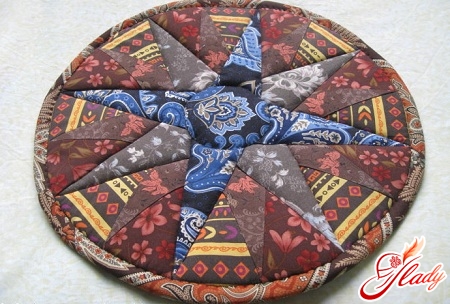
Types of quilting
Patchwork is a rather broad concept. This modern handicraft is represented by various types and techniques. Here are some (the most popular) types of patchwork.
- Traditional patchwork
Anglo-American handicraft, the purpose of which iscreating a single piece of fabric from individual patches folded into geometric patterns. This technique can be used to sew both a large bedspread and small potholders for the kitchen. As a rule, a sewn bedspread or smaller items have a front (patchwork) side and a lining.
- Crazy patchwork (crazy shred)
A type of patchwork that follows thea technology for making patchwork fabrics using arbitrary (irregular) figures, curved stripes and appliqués. In addition, the seams are masked with braid or embroidery, and the product itself (bedspread, pillow, panel, bag, clothing) is abundantly decorated with ribbons, beads, lace and other accessories.
- Knitted patchwork
Another variation of traditional patchwork,where a slightly different technology of joining the patches is used. Here, individual fragments are tied to each other using a contrasting thread and a crochet hook.
- Japanese patchwork
A patchwork sewing technique that combinesEastern and Western traditions. It actively uses quilting, and preference is given to silk fabrics, from which you can make a chic patchwork bedspread, a panel, and clothes. The patterns are based on traditional geometric shapes: squares, triangles, diamonds, corners.
- Quilting
Quilting is considered to be a broaderconcept than patchwork. However, in literal translation "quilting" is a quilted fabric. This is a technology for creating patterns using stitching, when a soft padding of synthetic padding, cotton wool or batting is placed between two pieces of fabric, and the pattern is embroidered with a machine stitch. A voluminous bedspread or blanket created using the quilting technique looks more elegant than one simply assembled from scraps. With equal success, this technique can be used to make potholders for the kitchen, sofa cushions or children's clothing.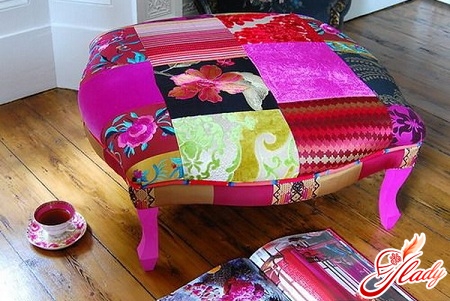
Techniques of quilting
Patchwork stitching technology at first glanceis quite simple: cut and sew, creating any product you want with your own hands: a bedspread, a tablecloth, a pillow, potholders for the kitchen or playful clothes for children. But this is only at first glance. Patchwork is a handicraft that requires not only the ability to handle a needle and thread, but also artistic taste, diligence, perseverance and accuracy. If you look at the samples of the products, then only one question arises. How exactly do you manage to create such different patterns using the same elements: blocks of stripes or individual stripes, squares, corners and triangles, diamonds? And it's all about different techniques, with the help of which the most incredible patterns are created. Let's look at some of the most popular techniques (methods) of patchwork sewing.
- Technique "Quick squares"
A very convenient technique for beginners.This method is used to make prefabricated square blocks (quick squares) cut from pre-sewn strips of fabric. Using this technique, you can make a large blanket in a matter of hours.
- Technique "Watercolor"
Quite a popular technique, which alsosquares are used. Sometimes squares are sewn into blocks from which the fabric is made. The main condition for a successful product is a correctly selected color scheme.
- Technique «Strip to strip»
Patchwork using multi-coloredstrips of fabric. When assembling a pattern from strips, their arrangement and combination can be varied as desired. In this way, it is easy to sew a playful rug or a large patchwork blanket in the form of laid parquet boards: ladder, zigzag, diamonds or corners. As a result, the strips produce patterns such as "Parquet", "Arable Land", "Herringbone" and "Well".
- The technique of "Log Hut"
Another way to sew from strips.In this technique, stripes are collected around a central square, laying them in a spiral. One of the variations of this technique is to shift the square to the corner. And for the clarity of the pattern, the drawing is collected from paired single-color stripes.
- The technique of "Magic Triangles"
Triangles are one of the most commonelements in patchwork. Not only was this figure attributed with magical powers, triangles are also very convenient to work with. They are used to make both simple squares and complex stars. Most often, right-angled isosceles triangles are used in patchwork. By sewing them together along the long side, two-color squares are obtained, and by connecting them along the short sides, patterns of multi-colored variegated stripes are obtained. The most popular patterns in which triangles are used are: "Mill", "Diamond", "Star".
- Technique «Patchwork corners»
Russian invention.The technique differs from all previous ones in that the corners are not cut out according to a template, but are folded from squares or strips of fabric. Then the resulting corners are collected into strips (tape) from which the fabric is sewn. With this patchwork technique, a three-dimensional fabric is obtained.
- Shakhmatka technique
Squares are also used here, or rather notsquares, but squares that are laid out in a checkerboard pattern. By the way, you can assemble a checkerboard pattern from diamonds by simply turning the squares at an angle. The pattern is assembled from elements of two contrasting colors.
- Technique «Russian square»
National Russian technology, distinguishedthe complexity of assembling a pattern based on a square, with the upper and lower tiers made up of isosceles triangles. The following tiers of the pattern are assembled from stripes and triangles. The tiers are either the same size or "growing" from the center to the edges.
- The Sota technique
Also known as "Grandmother's Garden".The fabric is assembled from hexagons and the pattern resembles a honeycomb. Sometimes a flower is assembled from hexagons, the middle of which is highlighted by a button covered with fabric.
- The technique of "Lapachikha"
A very original and playful way of patchworksewing, which results in a three-dimensional fabric. In this technique, raw colored stripes of fabric (lyapaki) are sewn onto the base. By the way, this is also a national Russian invention. In the imported version, a similar technique is known as "yo-yo". You can talk about patchwork techniques endlessly - how many patterns can be folded from different figures, so many techniques exist in patchwork. Therefore, let's dwell on what we have already considered, and in conclusion, let's talk about ideas for using types and techniques of patchwork.
The ideas of quilting
Do it yourself using colorful scrapsmanages to create truly masterpieces. Ideas for work can be drawn practically from thin air. Look around: what would you like to change in your home? Traditional or knitted patchwork is a great way to update interior textiles: blankets and bedspreads for the bed, throws and covers for the sofa and armchairs, tablecloths, rugs, kitchen potholders and towels - all this can be sewn with your own hands. Your clothes and accessories to them are also an inexhaustible source of inspiration. Any wardrobe items (except shoes) can be made from scraps. For example, an autumn jacket, for which it is better to use ideas and techniques of quilting or Japanese patchwork. From crazy fabric you can get elegant skirts or blouses, colorful vests that will dilute the severity of an office suit. And how many cute things can be sewn with your own hands for children, also taking the patchwork technique as a basis! And besides clothes, there are opportunities for patchwork sewing: bags and cosmetic bags, purses and cases, phone cases. In short, everything that can be sewn with your own hands can be sewn from scraps. There would be a desire, the skill of working with fabric, the ability to sew on a machine. And, of course, hard work, perseverance and passion. After all, only a passionate person can be almost a magician. And isn't that magic? Scrap by scrap, stitch by stitch - and here we have a miracle. Learn to be a sorceress! We recommend reading:




